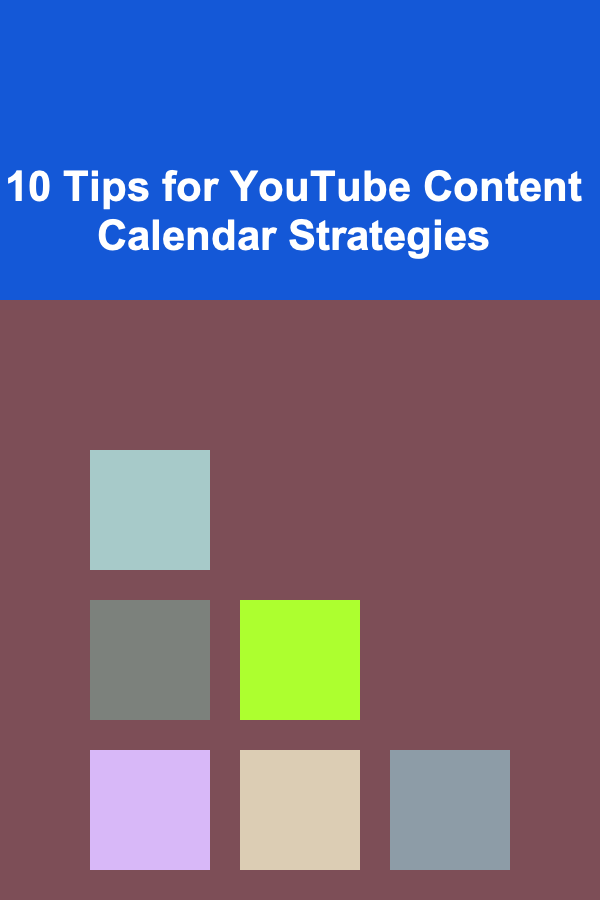
10 Tips for YouTube Content Calendar Strategies
ebook include PDF & Audio bundle (Micro Guide)
$12.99$10.99
Limited Time Offer! Order within the next:

YouTube has become one of the most powerful platforms for content creators, businesses, and marketers to engage with audiences, share information, and showcase their brand. However, the key to growing and maintaining a successful YouTube channel lies in consistency, strategic planning, and understanding what your audience truly wants. One of the most effective ways to stay on track is by implementing a content calendar strategy. A YouTube content calendar not only helps you plan your content in advance but also allows you to optimize your posting schedule, ensuring that your channel thrives over the long term.
In this article, we will delve into the 10 essential tips for creating and maintaining a YouTube content calendar strategy that can boost your channel's performance. Whether you are a solo content creator or managing a business channel, these strategies will help streamline your content production process, increase your reach, and grow your audience engagement.
Define Your Content Goals
The first step in creating a YouTube content calendar is to establish clear content goals. These goals will guide your content creation process and help you stay focused on your broader mission. Some common content goals include:
- Increasing subscriber count: If you're aiming to grow your audience, your content should encourage subscriptions through compelling calls to action.
- Boosting viewer engagement: Create content that sparks conversations, comments, and shares. Your calendar can help ensure that you're posting content that invites discussion.
- Establishing brand authority: If you're a business or influencer, creating educational or niche content can help establish your brand as an authority in your industry.
- Driving traffic to a website or product: If you're trying to sell products, create content that drives traffic to your eCommerce site or landing pages.
Without clear goals, your content will lack direction. Before diving into the content creation process, make sure you've defined what you want to achieve with your YouTube channel, whether it's increasing brand awareness, boosting sales, or simply growing your subscriber base.
Understand Your Audience
Another crucial step in creating a content calendar is understanding who your audience is. Your content strategy should cater to the specific needs and interests of your viewers. To do this effectively, consider:
- Audience demographics: What age group, location, and gender is most engaged with your channel? Understanding these factors can help tailor your content style and tone.
- Interests and pain points: What problems does your audience face, and how can you solve them? Your content should address the challenges and interests of your audience.
- Viewing habits: When is your audience most active on YouTube? You can use YouTube Analytics to find out what times and days are best to post content.
By understanding your audience, you will be able to create content that resonates with them, ensuring a better chance of engagement and growth.
Plan Your Content Themes and Series
The backbone of any successful YouTube content strategy is having consistent themes and series that your audience can look forward to. Instead of creating random, unrelated videos, planning your content around specific themes will help attract regular viewers.
- Niche-based content: Focus on creating content around a specific niche. For example, if you're a tech reviewer, create a series around new gadget reviews, tech tips, or tutorials.
- Content series: Organize your videos into series that build on one another. This could be a multi-episode tutorial or a weekly Q&A show. Series-based content keeps viewers coming back for more and can boost retention.
- Special events: Plan content around holidays, trending events, or global movements. This not only makes your content timely but also boosts discoverability.
For example, if your channel focuses on fitness, you could create a series on "30 Days of Fitness Challenges" or "Weekly Nutrition Tips."
Use a Content Calendar Template
Having a structured content calendar template is essential for staying organized and consistent. Whether you prefer digital tools or traditional pen and paper, using a calendar template will give you a visual representation of your publishing schedule.
There are various tools available to help you build a content calendar, such as:
- Google Calendar: You can schedule your video uploads and set reminders for deadlines.
- Trello: A project management tool that allows you to create boards for your video ideas, production schedule, and deadlines.
- Notion: A versatile tool that can be customized to create a content calendar along with other important details like video descriptions, hashtags, and SEO keywords.
- Airtable: Another great tool that allows you to organize your content ideas, video release dates, and track your content creation progress.
Choose the platform that suits your working style, and set aside time each week to fill it with video ideas, deadlines, and important notes for each piece of content.
Incorporate Consistency in Posting
Consistency is one of the most important factors in growing a YouTube channel. An erratic posting schedule can confuse your audience and hurt your channel's visibility in the YouTube algorithm. Use your content calendar to plan out a regular posting schedule, whether it's daily, weekly, or bi-weekly.
- Establish a realistic posting frequency: Choose a frequency that works with your production process. If you're a solo content creator, don't overcommit to daily uploads if you can't sustain them.
- Plan in advance: Create content in batches and schedule them ahead of time. This will alleviate the stress of last-minute uploads and allow you to focus on quality over quantity.
By sticking to a consistent posting schedule, you'll not only improve your chances of getting more subscribers but also signal to YouTube that your channel is active and engaged.
Optimize Your Content for SEO
Search Engine Optimization (SEO) is crucial for getting your videos in front of more viewers. With billions of videos on YouTube, ranking higher in search results is key to gaining visibility.
- Keyword research: Use tools like Google Keyword Planner, TubeBuddy, or VidIQ to find high-ranking keywords related to your video topics.
- SEO-friendly titles, descriptions, and tags: Include your target keywords in your video titles, descriptions, and tags to improve discoverability.
- Thumbnails and titles: Your thumbnail and video title are the first things people will notice, so make them compelling and relevant. Use bright colors, legible text, and images that convey the essence of your video.
A content calendar should include an SEO strategy for each video, ensuring you're not only posting consistently but also optimizing your videos for maximum reach.
Track Your Performance
Use analytics to track your content's performance and measure how well your videos are performing. YouTube Analytics provides insights into views, watch time, engagement, audience demographics, and more.
- Identify top-performing content: Track which videos get the most views, likes, and comments. Use these insights to replicate the elements of your successful videos.
- Analyze audience retention: If viewers are dropping off after the first few seconds, your video might not be engaging enough. Review your content and adjust it to improve retention.
- Adjust your strategy: Use the insights to modify your content calendar. For example, if you notice your audience prefers long-form content over short clips, adjust your posting strategy accordingly.
Tracking performance will help you refine your strategy, improve engagement, and continuously grow your channel.
Collaborate with Other Creators
Collaboration is a great way to expose your channel to new audiences and expand your reach. Collaborating with other YouTubers can bring fresh ideas, introduce new content styles, and generate a mutual audience benefit.
- Guest appearances: Invite other creators in your niche to appear in your videos, and offer to appear in theirs.
- Co-hosted series: Partner with a fellow YouTuber to create a co-hosted series that you can both promote to your audiences.
- Shoutouts and mentions: A simple shoutout or mention can lead to a cross-promotion that benefits both creators.
Integrating collaborations into your content calendar not only provides fresh content but also helps you tap into new audiences.
Repurpose Your Content
Repurposing your content is an efficient way to extend the life of your videos and get more value from your efforts. You don't have to create entirely new content all the time.
- Create shorter clips: Turn longer videos into shorter snippets or highlights to post on other platforms like Instagram or Twitter.
- Blog posts: Transform video content into written articles or blog posts on your website.
- Podcasts: Convert your videos into audio format and share them as podcasts.
By repurposing content, you can ensure that your ideas reach a wider audience and give more value to your original work.
Stay Flexible and Adjust
While a content calendar is a valuable tool for organizing and planning, it's important to remain flexible. The YouTube landscape is always evolving, with new trends, challenges, and algorithms that can impact your strategy.
- Be responsive to trends: If a viral trend or challenge aligns with your channel's niche, adjust your calendar to incorporate that content.
- Respond to feedback: If your audience suggests ideas or requests certain types of content, be willing to incorporate that feedback into your content calendar.
Staying adaptable will help you stay relevant and aligned with your audience's needs while keeping your content fresh and engaging.
Conclusion
A well-structured YouTube content calendar strategy is a critical component for success on the platform. By defining clear goals, understanding your audience, staying consistent, optimizing for SEO, and tracking your performance, you can create a content plan that not only keeps your channel organized but also positions you for growth and engagement. Through careful planning and flexibility, you'll be able to create content that resonates with your audience and keeps them coming back for more.
Reading More From Our Other Websites
- [Home Family Activity 101] How to Host a Family Bake-Off Competition at Home
- [Personal Care Tips 101] How to Choose a Shampoo for Gentle, Everyday Use
- [Home Budget Decorating 101] How to Create a Gallery Wall Without Breaking the Bank
- [Home Security 101] How to Create a Digital Home Security Strategy
- [Home Budget 101] How to Budget for a Large Purchase: A Home Buyer's Guide
- [Home Space Saving 101] How to Select Space-Saving Furniture for a Compact Home Office
- [Screen Printing Tip 101] Best Approaches to Screen Printing on Leather Jackets Without Cracking
- [Home Staging 101] How to Create a Cozy and Inviting Atmosphere Through Home Staging
- [Organization Tip 101] How to Choose the Right Ladder Stabilizers for Your Needs
- [Home Soundproofing 101] How to Soundproof Your Home Office for Virtual Meetings

Bargain Hunting 101: How to Find the Best Deals Every Time
Read More
How to Create an Effective File Organization System
Read More
How to Make Money Online as a Data Entry Specialist: 10 Actionable Ideas
Read More
How to Reassess Your Financial Situation During a Career Change
Read More
Discussing a Film's Soundtrack and Score: A Deep Dive
Read More
10 Tips for Managing Dental Anxiety in Children
Read MoreOther Products

Bargain Hunting 101: How to Find the Best Deals Every Time
Read More
How to Create an Effective File Organization System
Read More
How to Make Money Online as a Data Entry Specialist: 10 Actionable Ideas
Read More
How to Reassess Your Financial Situation During a Career Change
Read More
Discussing a Film's Soundtrack and Score: A Deep Dive
Read More